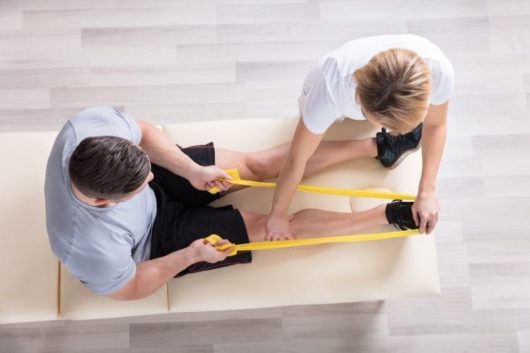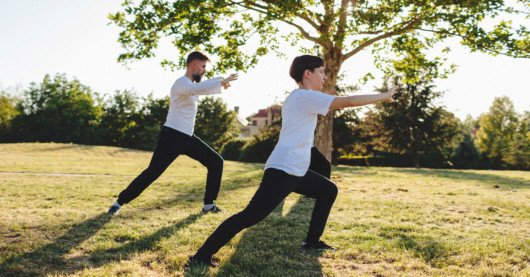You’re doing what every medical professional advises for your health: working out on a regular basis. Suddenly, an accident or circumstance comes out of nowhere, and now you’re sitting on the couch with an injury.
It’s happened to all of us, and admittedly, sometimes we use it as a reason to skip our workouts for a while. No more excuses, folks. As it turns out, there are plenty of ways to exercise while recovering from injuries.
All it takes is a change of pace to stay in shape without aggravating your injury. Depending on the injury you have, try these recovery-friendly workouts.
1. Swimming

You might not be doing any cannonballs off the diving board any time soon, but swimming is a great workout that’s gentle on your body. Swimming laps will work your cardiovascular system and the water acts as resistance training too.
Most importantly, the water pressure cushions your body so there’s no added impact on your joints. That makes swimming a great workout for people with almost any injury.
Can’t swim? No problem. Jogging laps in the pool provides the same benefits of cardio work and resistance training with little or no impact.
2. Cycling

Whether you want to feel the wind in your hair or you prefer a stationary bike in the gym, cycling can be a great way to stay in shape. Your body is performing many of the same motions as running but without the harsh impact.
Of course, it depends on the nature of your injury. Some knee injuries might not be well-suited to cycling, so check with your doctor first.
As an added bonus, you can customize your workouts on the bike. If you’re riding a stationary bike, you can lift dumbbells at the same time. You can also mix it up by switching between an upright bike and a recumbent bike to target different muscles.
3. Yoga

Yoga is an acquired taste for some, but it can be a great option if you have an injury. It combines bodyweight strength training, stretching, and meditation.
Some stretch-heavy yoga poses even help to heal injuries. For example, when injured with whiplash, poses like the ragdoll pose can stretch and loosen your neck.
The key is finding the right yoga workout. There are different forms of yoga with different focuses. Our top recommendation is to try some yoga videos on YouTube to see which ones feel the best for your body.
4. Walking

That’s right, good old walking. It’s as basic of a workout as it gets, but it has more benefits than you think.
Walking is a low-impact workout that works your cardiovascular system without going overboard. You can do it on the treadmill in front of your favorite TV show or you can head outside for some fresh air.
While you’re injured, though, make sure to stick with a stable walking path. Avoid rough terrains like hiking trails and areas with a lot of tree roots. Those obstacles increase your risk of falling or otherwise re-injuring yourself.
5. Strategic Weight-Lifting

Weight-lifting is a broad term for a workout. The fact is that you can still lift weights or use resistance bands when you’re injured. You just need to choose your moves with care.
First, focus on moves that don’t involve the injured area. If you have a lower-body injury, for example, use this as an opportunity to whip your upper body into shape.
Second, make your form your top priority. Stick with slow, smooth movements. If you’re ever unsure about your form for a particular move, the web is full of videos that will demonstrate it for you.
Finally, start small. Lower the weight you used to be able to handle. Work your way back up from there, little by little, while listening to your body.
6. Isometric Exercises

Isometric exercises are workout moves that isolate and target specific muscle groups. The exercises themselves involve very little movement. It’s more about purposefully contracting certain muscles over and over.
Barre workouts are an example of isometric exercises. These routines and classes have become popular over the past few years because they have so many advantages.
First, isometric exercises have little or no impact, so they’re injury friendly. Second, most of them use your bodyweight alone so there’s no need for pricey equipment.
Third, you can do these exercises in small spaces. They’re perfect for apartment-dwellers who want an at-home workout that fits in their living room and doesn’t disturb their downstairs neighbors.
7. Tai Chi

While its exact birthday is unknown, we know tai chi originated in ancient China and it continues to be used today. It would remind you of a blend between martial arts and yoga.
Tai chi involves slow, smooth movements in a variety of poses. It looks a lot like a yoga flow that keeps moving rather than stopping and holding each pose.
This slow, controlled movement makes tai chi an excellent choice if you have an injury. It’s impact-free and it uses your own bodyweight for strength training.
Like yoga, tai chi also has a meditative element to it. That’s an added bonus for injury recovery because stress can slow your healing process. Tai chi gives you your exercise fix and a dose of stress relief at the same time.
There are different styles of tai chi you can try. As with many other workouts, you can start with the countless videos on YouTube and elsewhere that let you follow along with tai chi instructors.
An injury doesn’t have to mean your fitness goals get put on hold. In fact, use it as an opportunity to get creative and try some workouts you’ve never tried before.
The exercises above can help you stay on track as you’re recovering from injuries. For more tips on protecting and enhancing your health no matter what your circumstances may be, check out more articles on our blog.



